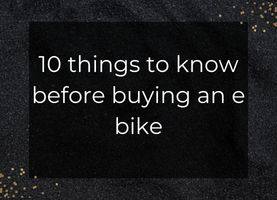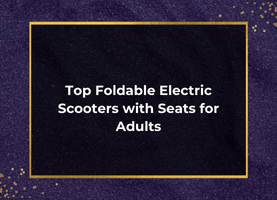
10 Things To Know Before Buying An E-Bike
E-bikes have surged in popularity, marking a significant shift in leisure and urban cycling habits. With the world grappling with traffic, pollution, and the search for sustainable mobility, e-bikes emerge as a compelling solution. Offering a blend of pedal power and electric assistance, they appeal to outdoor enthusiasts, fitness buffs, and daily commuters. Their eco-friendliness, ease of use, and versatility make e-bikes a top choice for a diverse range of users. Advances in technology have led to sleeker, lighter e-bikes with impressive battery life and performance, solidifying their role in modern urban travel.
Gaining knowledge before purchasing an e-bike ensures you make a well-informed decision, matching the right model to your lifestyle and needs. It helps avoid costly mistakes and enhances your riding experience by selecting a bike that truly fits your intended use and preferences.
Choosing your first e-bike? It's crucial to make an informed decision while keeping your safety at most important. Our guide, "10 Things to Know Before Buying an E-Bike," is designed to help you navigate the complexities of e-bikes, ensuring a satisfying purchase and maximizing the benefits of these innovative vehicles. Understanding key factors like intended use, terrain, distance, and motor assistance level is essential in selecting the right e-bike model. Considering battery capacity, motor power, and charging time will also ensure that your e-bike aligns with your specific needs, offering the range and performance you require.
-
Determine Your Needs
In the realm of electric bikes (e-bikes), understanding your specific requirements is paramount before making a purchasing decision. E-bikes come in various types designed for different purposes such as commuting, mountain biking, or leisurely rides. By identifying your primary use case, you can narrow down the options and find the e-bike that best suits your lifestyle and preferences.
Different types of e-bikes for various uses
E-bikes are not one-size-fits-all; they come in a variety of styles tailored to different riding experiences. For instance:
-
Commuting e-bikes typically feature a lightweight frame, efficient tires, and integrated accessories like racks and fenders for practicality.
-
Mountain e-bikes are built for rugged terrain, featuring robust suspension systems, durable frames, and knobby tires for traction.
-
Leisure e-bikes prioritize comfort and ease of use, often with step-through frames, upright riding positions, and ergonomic handlebars.
Assessing your primary use to find the right fit
To determine the most suitable e-bike for your needs, consider factors such as:
-
The distance and terrain of your typical rides.
-
Whether you'll be using the e-bike for commuting, recreation, or both.
-
Any specific features or accessories you may require, such as cargo-carrying capabilities or integrated lighting systems.Your budget and desired level of performance.
By carefully evaluating these aspects, you can make an informed decision and select an e-bike that aligns with your intended use and riding preferences.
-
Budget Considerations
The price of e-bikes can swing widely, influenced by the motor's type and performance, battery capacity and quality, frame materials, and component quality. More advanced motors and larger, high-quality batteries generally hike up the price, as do premium materials like carbon fiber and top-notch brakes, gears, and suspension. Brand reputation also plays a role, with established brands often commanding a premium.
When buying an e-bike, balancing quality with affordability is key. High-quality e-bikes, while pricier upfront, offer better performance, durability, and safety, providing greater long-term value than cheaper alternatives. However, affordable options might lead to higher maintenance costs down the line. Assess your budget, prioritize features that matter most to you, and you can find a sweet spot between cost and quality, ensuring your e-bike is a worthy investment.
-
Understanding E-Bike Motors
Understanding the types of motors used in e-bikes is key to selecting the right bike for your needs, as the motor significantly influences the bike's performance, efficiency, and overall riding experience.
Hub Motors: Hub motors are a popular choice for many e-bikes due to their simplicity and cost-effectiveness. Located in either the front or rear wheel's hub, these motors propel the bike by directly spinning the wheel. Their straightforward design makes them easy to install and maintain, contributing to their widespread use in entry-level and mid-range e-bikes. However, the placement of hub motors can affect the bike's weight distribution, potentially impacting handling and traction, especially on uneven surfaces or during sharp turns.

Mid-Drive Motors: Mid-drive motors are positioned at the bike's crankshaft, centralizing the weight and offering a more balanced ride. This type of motor leverages the bike's existing gears, allowing for efficient power use and improved performance on varied terrains, particularly when climbing hills. Mid-drive systems provide a natural feeling of propulsion and better handling by maintaining the bike's center of gravity closer to its original state. Although typically more expensive and complex than hub motors, mid-drive motors are favored for high-performance and off-road e-bikes due to their efficiency and the enhanced riding experience they offer.

When choosing an e-bike, understanding these motor types helps you find a model that suits your riding style and preferences, whether you prioritize simplicity and cost savings with a hub motor or the balanced performance and efficiency of a mid-drive motor.
-
Battery Life and Range
Battery life and range are pivotal factors in the performance and usability of electric bikes (e-bikes). The battery dictates how far an e-bike can travel on a single charge, influencing the rider's freedom and the bike's suitability for long commutes or adventurous rides.
Battery Life: This refers to the lifespan of the battery before it needs replacement, typically measured in charge cycles. A high-quality e-bike battery can last between 500 to 1,000 charge cycles under optimal conditions. Factors like temperature, storage habits, and charging practices can significantly affect battery life. To maximize lifespan, it's recommended to keep the battery charged between 20% and 80% and avoid extreme temperatures.
Range: The range of an e-bike – how far it can travel on one charge – varies based on the battery's capacity (measured in watt-hours, Wh), the rider's weight, terrain, and usage patterns (such as the level of pedal-assist used). On average, e-bike batteries offer ranges from as little as 15 miles on high-power settings to over 50 miles in more efficient modes. Understanding an e-bike's range is crucial for planning trips and ensuring the bike meets your needs for distance and performance.
When choosing an e-bike, consider both the battery life and range to ensure it aligns with your riding style and requirements. This consideration will help secure a satisfying e-bike experience, offering the right balance of freedom and reliability for your cycling adventures.
Understanding these factors can help e-bike riders gauge the expected range per charge and make informed decisions about battery selection, usage, and maintenance to maximize the lifespan and efficiency of their e-bike batteries.
-
Pedal Assist vs. Throttle Control
Pedal assist and throttle control significantly alter the e-bike experience. Pedal assist mirrors traditional cycling, enhancing your effort with motorized help, ideal for exercise enthusiasts or those facing long rides and steep inclines. It extends battery life by integrating your pedaling energy. Throttle control offers a more effortless ride, propelling the bike without pedaling, perfect for those seeking convenience or a rest during their journey, though it may reduce battery range quicker. Your choice shapes your ride, blending activity levels with the ease of electric power.
Pedal assist and throttle control represent two distinct methods of e-bike power delivery, each offering a unique riding experience.
Pedal Assist: This system activates the motor only when the rider is pedaling, providing a boost proportional to the rider's effort. It's designed to augment, not replace, human power, offering a more natural biking experience. E-bikes with pedal assist typically have settings (or levels) that riders can adjust based on their desired level of effort. This mode is ideal for those looking to combine exercise with the convenience of motor assistance, making longer rides or challenging hills more manageable.

Throttle Control: E-bikes with throttle control allow the rider to engage the motor with a simple push of a button or twist of the handle, similar to a motorcycle or scooter. This feature can propel the bike forward without any pedaling required from the rider. Throttle control is perfect for those seeking a break from pedaling or needing instant power, offering a more relaxed ride. However, using throttle alone can drain the battery faster than pedal assist.

Choosing between pedal assist and throttle control, or opting for a model that offers both depends on personal preference, riding conditions, and what you hope to get out of your e-bike experience. Pedal assist keeps you active and extends battery life, while throttle control provides effortless speed and convenience.
-
Frame Material and Design
The choice of frame material in an e-bike significantly affects its weight, durability, and cost, while the design plays a crucial role in comfort and how the bike is used. Let’s have a look on both:
Frame: Frame material significantly impacts an e-bike's weight, durability, and cost. Aluminum is lightweight and affordable, ideal for general use. Steel offers unmatched durability and a comfortable ride due to its shock-absorbing properties but adds weight. Carbon fiber is the lightest and strongest, perfect for performance-focused riders, though it's the most expensive.
Design: Design choices affect comfort and usage. Step-through frames ease access, suited for casual riding and those wearing restrictive clothing. Frame geometry influences posture and comfort over long distances. The e-bike's intended use dictates its design: mountain e-bikes emphasize stability for rough terrain, road e-bikes optimize for speed with aerodynamic shapes, and folding designs offer portability for urban commuters.
Choosing the right frame material and design ensures a balance between performance, comfort, and cost, tailored to the rider's needs and preferences.
-
Braking Systems
Braking systems are crucial for the safety and control of an e-bike, with mechanical and hydraulic brakes being the two primary types each offering distinct advantages.
Mechanical vs. Hydraulic Brakes
When considering the safety and control features of an e-bike, understanding the braking system is crucial. E-bikes typically come with either mechanical or hydraulic brakes, each with its own set of benefits and considerations.

Mechanical Brakes: These operate via a cable system that, when engaged, pulls the brake pads against the wheel or rotor to slow the bike. They are simpler, easier to repair, and more cost-effective but may require more manual effort for the same stopping power.
Hydraulic Brakes: These use fluid to transfer force from the brake lever to the brake pads. Hydraulic brakes offer superior stopping power with less effort, consistent performance in varied conditions, and minimal maintenance. However, they are more complex and can be more expensive to repair.
Choosing between mechanical and hydraulic brakes for your e-bike depends on various factors, including your riding style, maintenance preferences, and budget. Mechanical brakes might appeal to those who prioritize simplicity and cost-effectiveness, while hydraulic brakes are suited for riders seeking enhanced performance and minimal maintenance. Ultimately, the decision should align with your needs, ensuring a safe and enjoyable riding experience.
Safety Features of High-Quality Brakes
High-quality braking systems, especially hydraulic ones, provide enhanced safety features:
Immediate Response: They offer quicker and more reliable stopping, crucial in emergency situations.
Better Modulation: This refers to the ability to control the braking intensity, allowing for smoother deceleration and more control over the bike.
Less Fatigue: Especially on long descents or in stop-and-go urban environments, requiring less force from the rider reduces hand fatigue, maintaining control and safety.
Choosing the right braking system involves considering your riding conditions, maintenance preferences, and safety requirements. Reliable brakes not only protect you by ensuring immediate stopping power but also enhance the overall riding experience by offering better control and confidence, regardless of weather conditions or terrain.
-
Gearing and Performance
The gearing system of an e-bike plays a crucial role in determining its performance, particularly in terms of speed, efficiency, and ease of handling across different terrains. Understanding the nuances between single-speed and multi-speed options can help riders choose an e-bike that aligns with their riding style and needs.
The Role of Gears in E-Bike Performance: Gears influence how much effort the rider needs to pedal, especially on inclines or at high speeds. They allow for adjustments to maintain comfortable pedaling cadence across a variety of conditions.
Single-Speed vs. Multi-Speed Options: Single-speed e-bikes offer simplicity and lower maintenance, making them ideal for flat terrains and urban environments. Multi-speed e-bikes, with their range of gears, provide versatility and better performance on varied terrains, including steep hills.
Selecting the right gearing system is pivotal in maximizing the performance of your e-bike. While single-speed models cater to those seeking simplicity and minimal maintenance, multi-speed options offer enhanced versatility and control, essential for more demanding rides or diverse terrains.
-
Test Riding Is Essential
Test riding various e-bike models is a critical step in the purchasing process. It allows potential buyers to experience firsthand the feel, performance, and suitability of different bikes, ensuring a match between the e-bike and the rider's expectations.
The Value of Test Riding Multiple Models: Test riding helps in comparing the handling, comfort, and features of various e-bikes. It's an opportunity to assess how different models perform in real-world conditions.
What to Look for During a Test Ride: Pay attention to the bike's fit, ease of use, response to inputs, and how well it handles your typical riding conditions. Comfort, performance, and any unique features should be evaluated.
A thorough test ride can reveal a lot about an e-bike's suitability for your needs. It's an invaluable step in finding the perfect match, ensuring that you invest in a bike that meets your expectations in comfort, performance, and enjoyment.
-
Warranty and After-Sales Service
A robust warranty and reliable after-sales service are vital considerations when purchasing an e-bike. They not only provide peace of mind but also ensure the longevity and continuous enjoyment of your investment.
Importance of a Good Warranty: A comprehensive warranty covers potential issues and defects, safeguarding your investment. It reflects the manufacturer's confidence in their product and commitment to customer satisfaction.
Availability of After-Sales Service and Parts: Easy access to after-sales service and parts is crucial for maintaining your e-bike in optimal condition. It ensures that any problems can be promptly and effectively addressed, minimizing downtime.
The quality of warranty and after-sales service significantly impacts the overall value and reliability of an e-bike. Opting for a bike from a manufacturer that offers strong support and service guarantees a better ownership experience, ensuring your e-bike remains a source of joy and utility for years to come.
The cornerstone of any e-bike selection endeavor lies in a meticulous appraisal of your intended usage scenarios. E-bikes manifest in diverse forms tailored for specific purposes, encompassing commuting, off-road adventures, or leisurely excursions. By discerning your predominant requirements, you can effectively streamline your options and pinpoint the e-bike model best aligned with your lifestyle and preferences.
Follow Us
Trending Articles
Newsletter
Aliqu justo et labore at eirmod justo sea erat diam dolor diam vero kasd



